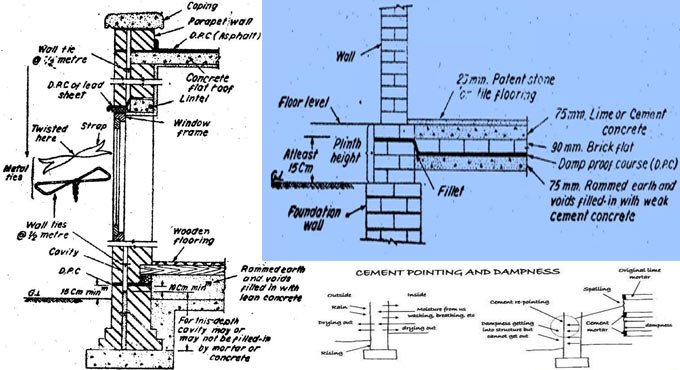NEWS | SOFTWARE | SHEET
Five Techniques to Avert Dampness in Structure
Techniques to avert dampness: The subsequent are the measures to be implemented in order to avert moisture in structures, prior to the implementation of different methods.
i. The base must be placed on elevation and soil which lets water to seep through it quite swiftly and not accumulate [in order to protect from dampness].
ii. The accessible walls must be of adequate breadth in order to protect from rain (least 30 cm).
iii. High quality bricks without any imperfections must be utilized.
iv. High quality cement mortar [1:3] must be utilized in order to generate specific design (pattern) and ideal fastening in the structure.
v. Course of bricks and moldings must be presented in order to drive rainwater off [from the walls].
vi. The accessible exteriors such as compound walls, wall tops, etc must be protected with waterproof cement plaster.
vii. Cavity walls are more dependable than solid walls in averting the moisture.
Utilization of damp-proof courses (DPC): Those are membranes or coatings of water opposing substances like mastic asphalt, cement concrete, bituminous felts, plastic sheets, metal sheets, stones, mortar, etc that are introduced in the construction structure at every point where water ingress is expected or assumed.
The most excellent spot or place of DPC with respect to a structure with no cellar placed at the base [plinth] floor [level] or buildings with no base [plinth] floor [level], it must be put relatively fifteen cm higher than the first floor. DPC [damp proof course] is presented uprightly and levelly in walls, floors, etc.
Waterproof exterior procedures: The exterior procedure comprises sealing the substance minute openings that could be open to dampness through presenting a fine layer of water opposing substance on top of the surface [interior/exterior]. Exterior procedure is efficient in averting moisture.
Hollow Walls or Cavity Walls: A cavity wall comprises two analogous sheets [leaves] or walls or masonry skins segregated through a consistent gap or empty space. The arrangement of consistent gap in the wall efficiently averts the passage or seepage of moisture from external walls or sheet to interior wall or sheet.
Guniting [Shotcrete]: The method of guniting comprises creating a impermeable covering of rich cement mortar [1:3] or sand [fine aggregate] mixture for waterproofing on top of the accessible concrete facade or on top of the tanks, channels, etc for opposing the water force [pressure]. Through the method, an impermeable covering of good compressive strength (six hundred to seven hundred kg/cm2) is attained and therefore that is quite effective for fixing or restoring concrete establishments.
Pressure Cementing [Grouting] or Fastening [Cementation]: The combination of sand, cement and water pushed into the crevices, gaps or holes in the ground or constructional part. Generally, the foundations are offered this remedy in order to avert the dampness seepage. The method is also utilized for fixing constructions, integrating ground in order to enhance bearing potential, creating water checks to avert leakage, etc.
Article Source: civilblog.org


